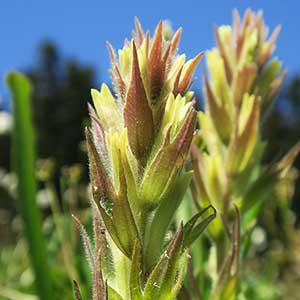Castilleja cryptantha
Castilleja patriotica
Mt. Rainier or obscure paintbrush, obscure Indian paintbrush, obscure paintbrush
Huachuca Mountain Indian paintbrush, native paintbrush
few to several, erect or ascending, unbranched, hairs spreading, long, soft, eglandular, mixed with short stipitate-glandular ones.
few to many, erect or ascending, much-branched with many short, leafy axillary shoots, hairs recurved to retrorse, short, ± stiff, eglandular, often with some spreading, long ones.
green, often with brown or purple veins, narrowly to broadly lanceolate, 1.5–4 cm, not fleshy, margins plane, ± involute, 0–3-lobed, apex acute to acuminate;
lobes spreading-ascending, narrowly lanceolate, apex acute to ± obtuse.
green, linear-lanceolate to lanceolate, 1–3.5 cm, not fleshy, margins plane, sometimes ± wavy, flat to involute, (0–)3–7-lobed, apex acute to obtuse;
lateral lobes spreading, linear, much shorter and narrower than terminal lobe, apex acute.
(2.5–)3–6 × 1–2 cm; green to dull brown or dull reddish purple throughout, or proximally green to dull brown or dull reddish purple, distally yellow on apices, broadly lanceolate to ovate, (0–)3-lobed;
lobes ascending, narrowly lanceolate, long or short, arising near mid length, apex acute or acuminate.
3–17 × 2–7.5 cm;
bracts green throughout, sometimes distalmost proximally green, distally red or red-orange on apices, lanceolate or broadly lanceolate, (0–)3–5-lobed;
lobes spreading, linear or narrowly lanceolate, short, arising near or below mid length, central lobe apex obtuse to rounded, lateral ones acute.
straight, 14–16 mm;
tube 11–14 mm;
whole corolla included within calyx;
beak adaxially pale yellow, 1–2 mm;
abaxial lip deep green, slightly inflated, 4–5 mm, 67% as long as beak;
teeth ascending, pale, 1.5–2 mm.
slightly curved, (24–)27–43 mm;
tube 9–20 mm;
beak longer than calyx, exserted through abaxial cleft, adaxially green to yellowish, 22–39 mm;
abaxial lip deep green, inflated, tight, 1–2.5 mm, 5–10% as long as beak;
teeth often spreading, green or white, 0.5–1.6 mm.
proximally green or pale with green veins, lobes yellow, sometimes becoming deep red with age, 12–15 mm;
abaxial and adaxial clefts 3–7 mm, 25–50% of calyx length, deeper than laterals, lateral 1–3(–4) mm, 8–20% of calyx length;
lobes triangular, adaxial segments longer than abaxials, apex acute or obtuse.
proximal 1/3 green, distal 2/3 red to pale red-orange, rarely yellow, (17–)25–35(–40) mm;
abaxial clefts 14–29 mm, 67–75% of calyx length, adaxial 2.5–7.3 mm, 5–15% of calyx length, deeper than laterals, lateral 0–0.3(–2) mm, 0–5% of calyx length;
lobes broadly triangular, entire or shallowly cleft, segments, if present, often differing in length, apex acute, obtuse, or rounded.
= 24.
= 24.
Castilleja cryptantha
Castilleja patriotica
Castilleja cryptantha is endemic to the vicinity of Mt. Rainier in the Cascade Range, with most populations found within Mt. Rainier National Park. Unlike most species of Castilleja, it is apparently self-pollinating (W. J. Duffield 1972); the small flowers are entirely enclosed within the yellowish calyces, which tend to grow deep reddish as they age. The purplish brown bracts are also unusual in the genus.
(Discussion copyrighted by Flora of North America; reprinted with permission.)
Castilleja patriotica is broadly distributed in the northern Sierra Madre Occidental in Mexico, south to northern Durango and Sinaloa. It is replaced in central and southern Mexico by a related species, C. pectinata M. Martens & Galeotti. Castilleja patriotica reaches the Chiricahua and Huachuca mountains of southeastern Arizona and the adjacent Animas Mountains of southwestern New Mexico. A report from the Atascosa Mountains of southern Arizona needs verification. The numerous, narrow axillary leaves and the narrow leaf lobes combine to give this plant a curious frilly appearance. The narrow, widely divaricate lateral leaf lobes are unique in the flora area. Short, compact plants with smaller flowers were named C. blumeri. Castilleja patriotica has medicinal value to native peoples of the northern Sierra Madre.
(Discussion copyrighted by Flora of North America; reprinted with permission.)


